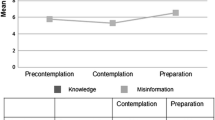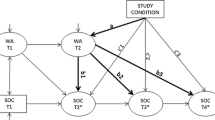Abstract
Voluntary medical male circumcision (VMMC) is an evidence-based biomedical HIV prevention method. It is under-utilized in countries outside Africa, including China. The present single-arm, non-blinded test-of-concept trial was designed to promote VMMC among 179 male sexually transmitted diseases patients (MSTDP) in Shenzhen, China. It was based on behavioral health theories and results of a formative survey. At month 4, 45.5 % of the MSTDP responded positively to the intervention (19.9 % had taken up VMMC and 25.6 % intended to do so in the next 6 months). Adjusted analysis showed that cognitive variables measured at baseline (perceived self-efficacy, subjective norm and behavioral intention) significantly predicted adoption of VMMC during the 4-month follow-up period. Process evaluation involving clinicians of the STD clinics was positive. At month 6, 36.0 % of the circumcised participants used condom less frequently with their regular sex partner. We recommend scaling up the intervention, taking prevention of risk compensation into account.

Similar content being viewed by others
References
Auvert B, Taljaard D, Lagarde E, Sobngwi-Tambekou J, Sitta R, Puren A. Randomized, controlled intervention trial of male circumcision for reduction of HIV infection risk: the ANRS 1265 Trial. PLoS Med. 2005;2(11):e298.
Bailey RC, Moses S, Parker CB, Agot K, Maclean I, Krieger JN, et al. Male circumcision for HIV prevention in young men in Kisumu, Kenya: a randomised controlled trial. Lancet. 2007;369(9562):643–56.
Gray RH, Kigozi G, Serwadda D, Makumbi F, Watya S, Nalugoda F, et al. Male circumcision for HIV prevention in men in Rakai, Uganda: a randomised trial. Lancet. 2007;369(9562):657–66.
Siegfried N, Muller M, Deeks JJ, Volmink J. Male circumcision for prevention of heterosexual acquisition of HIV in men. Cochrane Database Syst Rev. 2009;2:CD003362.
Tobian AA, Serwadda D, Quinn TC, Kigozi G, Gravitt PE, Laeyendecker O, et al. Male circumcision for the prevention of HSV-2 and HPV infections and syphilis. N Engl J Med. 2009;360(13):1298–309.
Auvert B, Sobnqwi-Tambekou J, Culter E, Nieuwoudt M, Lissouba P, Puren A, et al. Effect of male circumcision on the prevalence of high-risk human papillomavirus in young men: results of a randomized controlled trial conducted in Orange Farm, South Africa. J Infect Dis. 2009;199(1):14–9.
Weiss HA, Thomas SL, Munabi SK, Hayes RJ. Male circumcision and risk of syphilis, chancroid, and genital herpes: a systematic review and meta-analysis. Sex Transm Infect. 2006;82(2):101–9; discussion 10.
Sobngwi-Tambekou J, Taljaard D, Nieuwoudt M, Lissouba P, Puren A, Auvert B. Male circumcision and Neisseria gonorrhoeae, Chlamydia trachomatis and Trichomonas vaginalis: observations after a randomised controlled trial for HIV prevention. Sex Transm Infect. 2009;85(2):116–20.
Gray RH, Kigozi G, Serwadda D, Makumbi F, Nalugoda F, Watya S, et al. The effects of male circumcision on female partners’ genital tract symptoms and vaginal infections in a randomized trial in Rakai, Uganda. Am J Obstet Gynecol. 2009;200(1):42 e1–7.
Reed JB, Njeuhmeli E, Thomas AG, Bacon MC, Bailey R, Cherutich P, et al. Voluntary medical male circumcision: an HIV prevention priority for PEPFAR. J Acquir Immune Defic Syndr. 2012;60(Suppl 3):S88–95.
Centers for Disease Control and Prevention. Progress in voluntary medical male circumcision service provision—Kenya, 2008–2011. MMWR Morb Mortal Wkly Rep. 2012;61(47):957–61.
Njeuhmeli E, Forsythe S, Reed J, Opuni M, Bollinger L, Heard N, et al. Voluntary medical male circumcision: modeling the impact and cost of expanding male circumcision for HIV prevention in eastern and southern Africa. PLoS Med. 2011;8(11):e1001132.
Ning C, Jiang J, Ye L, Yang X, Wei B, Deng W, et al. Comparison of three intervention models for promoting circumcision among migrant workers in western China to reduce local sexual transmission of HIV. PLoS One. 2013;8(9):e76107.
Mullen PD, Evans D, Forster J, Gottlieb NH, Kreuter M, Moon R, et al. Settings as an important dimension in health education/promotion policy, programs, and research. Health Educ Q. 1995;22(3):329–45.
Leenaars PE, Rombouts R, Kok G. Service attributes and the choice for STD health services in persons seeking a medical examination for an STD. Soc Sci Med. 1994;38(2):363–71.
Celum CL, Bolan G, Krone M, Code K, Leone P, Spaulding C, et al. Patients attending STD clinics in an evolving health care environment. Demographics, insurance coverage, preferences for STD services, and STD morbidity. Sex Transm Dis. 1997;24(10):599–605.
Chen XS, Peeling RW, Yin YP, Mabey DC. The epidemic of sexually transmitted infections in China: implications for control and future perspectives. BMC Med. 2011;9:111.
Janz NK, Becker MH. The health belief model: a decade later. Health Educ Q. 1984;11(1):1–47. Retrieved from http://heb.sagepub.com/content/11/1/1.short.
Sweat M, O’Donnell C, O’Donnell L. Cost-effectiveness of a brief video-based HIV intervention for African American and Latino sexually transmitted disease clinic clients. AIDS. 2001;15(6):781–7.
Desgrees-Du-Lou A, Brou H, Djohan G, Becquet R, Ekouevi DK, Zanou B, et al. Beneficial effects of offering prenatal HIV counselling and testing on developing a HIV preventive attitude among couples. Abidjan, 2002–2005. AIDS Behav. 2009;13(2):348–55.
Warner L, Klausner JD, Rietmeijer CA, Malotte CK, O’Donnell L, Margolis AD, et al. Effect of a brief video intervention on incident infection among patients attending sexually transmitted disease clinics. PLoS Med. 2008;5(6):e135.
Cohen DA, MacKinnon DP, Dent C, Mason HR, Sullivan E. Group counseling at STD clinics to promote use of condoms. Public Health Rep. 1992;107(6):727–31.
Herbst JH, Sherba RT, Crepaz N, Deluca JB, Zohrabyan L, Stall RD, et al. A meta-analytic review of HIV behavioral interventions for reducing sexual risk behavior of men who have sex with men. J Acquir Immune Defic Syndr. 2005;39(2):228–41.
Mehta P, Sharma M, Lee RC. Designing and evaluating a health belief model-based intervention to increase intent of HPV vaccination among college males. Int Q Community Health Educ. 2013;34(1):101–17.
Reback CJ, Ling D, Shoptaw S, Rohde J. Developing a text messaging risk reduction intervention for methamphetamine-using MSM: research note. Open AIDS J. 2010;4:116–22.
Ajzen I. The theory of planned behavior. Organ Behav Human Decis Process. 1991;50:179–211.
Wang Z. Male circumcision as a bio-medical HIV intervention targeting male heterosexual sexually transmitted disease (STD) patients in china—an acceptability study and a single-arm test-of-concept trial. Ph.D. Thesis, The Chinese University of Hong Kong. 2013.
Prochaska JO, DiClemente CC, Norcross JC. In search of how people change. Applications to addictive behaviors. Am Psychol. 1992;47(9):1102–14.
McAninch JW. Smith & Tanagho’s general urology. 18th ed. New York: McGraw-Hill Medical; 2013.
Calderon Y, Haughey M, Bijur PE, Leider J, Moreno-Walton L, Torres S, et al. An educational HIV pretest counseling video program for off-hours testing in the emergency department. Ann Emerg Med. 2006;48(1):21–7.
Chiasson MA, Shaw FS, Humberstone M, Hirshfield S, Hartel D. Increased HIV disclosure three months after an online video intervention for men who have sex with men (MSM). AIDS Care. 2009;21(9):1081–9.
Araujo MA, Montagner MA, da Silva RM, Lopes FL, de Freitas MM. Symbolic violence experienced by men who have sex with men in the primary health service in Fortaleza, Ceara, Brazil: negotiating identity under stigma. AIDS Patient Care STDS. 2009;23(8):663–8.
Bellg AJ, Borrelli B, Resnick B, Hecht J, Minicucci DS, Ory M, et al. Enhancing treatment fidelity in health behavior change studies: best practices and recommendations from the NIH Behavior Change Consortium. Health Psychol. 2004;23(5):443–51.
Acknowledgments
The authors gratefully thank the study participants, clinicians and directors of the collaborative STD clinics for their contribution. The study was supported by the National Natural Science Foundation of China (Ref#: 81373054).
Author information
Authors and Affiliations
Corresponding author
Additional information
Zixin Wang and Tiejian Feng have contributed equally to this manuscript.
Rights and permissions
About this article
Cite this article
Wang, Z., Feng, T. & Lau, J.T.F. Needs Assessment and Theory-Based Promotion of Voluntary Medical Male Circumcision (VMMC) Among Male Sexually Transmitted Diseases Patients (MSTDP) in China. AIDS Behav 20, 2489–2502 (2016). https://doi.org/10.1007/s10461-015-1040-z
Published:
Issue Date:
DOI: https://doi.org/10.1007/s10461-015-1040-z




